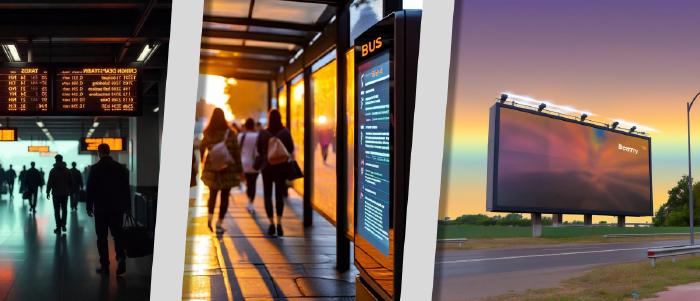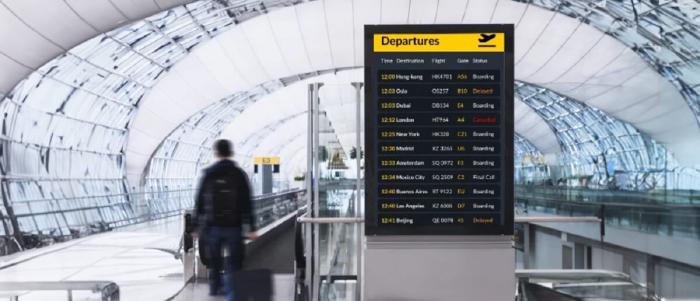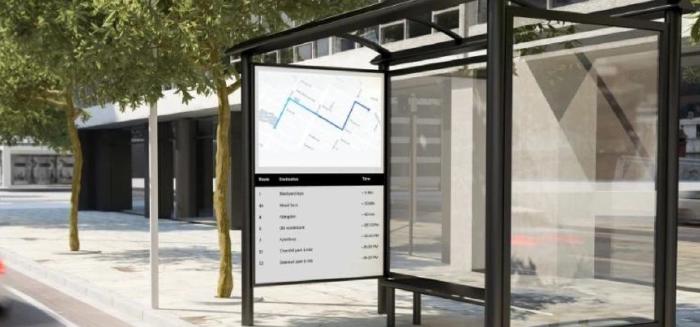
May 19 2025
5 min read

Digital signage is transforming how travelers navigate and experience airport spaces across the USA. These dynamic displays are simplifying operations, boosting communication, and raising passenger satisfaction levels through interactive navigation, targeted advertising, and real-time flight information. Digital signage in USA is increasingly crucial for establishing a smooth, stress-free, and contemporary travel experience as airports get busier.

In the U.S., delays in flight schedules are common due to weather, technical glitches or air traffic control interventions. Flight Information Display Systems (FIDs), which provide real-time information on arrivals, departures, and gate changes, are powered by digital signage software in USA airports.
Large LED panels and video walls at airports like Chicago O’Hare guarantee that travelers can view flight updates from a distance.
This keeps passengers informed by lowering the need for overworked employees and public address systems. Employees may rapidly change several screens with centralized content management systems, ensuring uniformity across terminals.
Navigating large airport terminals is one of the main challenges faced by passengers in the United States. Interactive navigation displays are one way that digital signage in US airports handles this. Clear, multilingual directions to gates, toilets, eating options, and baggage claim facilities are displayed on these screens.
To help first-time or foreign visitors, interactive kiosks at airports such as Dallas/Fort Worth International Airport provide touch-friendly maps to guide passengers. Passengers may move more effectively and avoid missing flights by using these technologies, which provide real-time information like gate changes or security wait times.
In crowded US airports, lengthy layovers and security queues are commonplace. This is addressed by digital signage, which uses interesting material to cut down on perceived wait times. In order to keep passengers interested, waiting room screens show sports, local news, and even interactive games. Orlando International Airport, for instance, entertains and diverts tourists with Imaginative installations like the “Fish Bowl” show.
Additionally, airports like Charlotte Douglas International feature digital art installations, such as the parametric digital art by Refik Anadol, which not only beautify the space but also provide travelers with a glimpse into the local art scene.

Due to their varied audiences and lengthy stay durations, airports are excellent locations for advertising. A digital signage player in USA airports allows duty-free stores, eateries, and neighborhood businesses to have dynamic ad displays.
Research by Nielsen indicates that 80% of frequent flyers notice airport advertisements, with 42% taking subsequent actions such as visiting a website, exploring a store, or seeking more information about a product or service. Notably, 19% of these travelers proceed to purchase a product they saw advertised at the airport.
By highlighting local amenities and offers, digital signage not only boosts non-aeronautical revenue streams for airports but also enhances the overall passenger experience by providing timely and relevant information.
Airport security is a major concern in the United States, as congested terminals and strict rules necessitate effective communication. On-premise digital signage in USA airports guarantees reliable, locally controlled systems that provide security alerts, such as TSA regulations regarding gadgets or beverages.
These screens have the ability to rapidly broadcast safety advice, exit routes, and notifications during crises. For instance, digital signage informs travelers of flight disruptions during severe weather events, which are prevalent in areas like the Midwest, lowering anxiety and guaranteeing safety.
This critical capability extends beyond airports, proving equally vital for public safety and information dissemination in other sectors, such as USA local councils and government services.
Airport signs systems need to be safe since they handle sensitive data and are very visible. In order to prevent unwanted access, digital signage security in USA airports uses strong encryption, secure user logins, and Active Directory connectivity.
Airports may maintain control over data and ensure compliance with aviation rules by using on-premise systems, such as those utilized at San Francisco International Airport. Frequent software upgrades and monitoring help reduce the danger of hacking and secure passenger data and airport operations.
Airports in the United States serve a worldwide clientele, and many travelers need accessible or bilingual services. This is made possible by digital signage, which integrates features like wheelchair-accessible navigation and one-tap assistance requests, and provides material in several languages.
In order to ensure inclusion, airports such as Seattle-Tacoma International employ bilingual interfaces at information desks to help non-native English speakers. Airports can better serve a variety of passenger demands by optimizing content placement and timing with the use of analytics from signage systems.
Digital signage is at the vanguard of a smarter, more connected airport experience as the aviation industry in the United States continues to become more competitive and sophisticated. With the help of AI, biometrics, and augmented reality, this technology is developing beyond static screens to provide travelers with individualized, real-time solutions that streamline their travel experience.
Digital signage has completely changed how airports interface with passengers, from improving safety and ease of navigation to increasing engagement and income. It is more than just a tool at a time when experience and efficiency go hand in hand; it is a force that is revolutionizing American air travel.






May 19 2025
5 min read

Dec 1 2023
5 min read

Sep 21 2023
7 min read

Apr 25 2023
5 min read
Take complete control of what you show on your digital signage & how you show it.
Start Free Trial Schedule My Demo